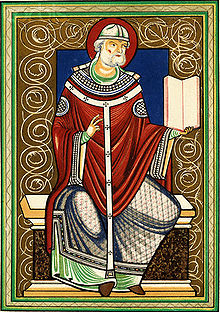- Origins of the Papal Tiara
-
 Pope Innocent III (1198-1216) in early papal tiara, Fresco at the cloister Sacro Speco, about 1219.
Pope Innocent III (1198-1216) in early papal tiara, Fresco at the cloister Sacro Speco, about 1219.
The origins of the Papal Tiara remain somewhat clouded in mystery. The word tiara itself occurs in the classical annals to denote a Persian headdress, particularly that of the "great king."[1] A camelaucum which was similar in shape to papal tiaras, was part of court dress in Byzantium. Given that other rituals associated with the Papal Coronation, notably the use of the sedia gestatoria, were copied from Byzantine and eastern imperial ceremonial, it is likely that the tiara is also of Byzantine origin.
Contents
First mention
A form of papal crown is first mentioned in the vita of Pope Constantine (eighth century) contained in the Liber Pontificalis; there it is called a camelaucum, a folded cap of white linen that was part of Byzantine court dress. A contemporary depiction of Gregory the Great (died 604) shows such a cap. Coins of Pope Sergius III (904-11) and Pope Benedict VII (974-983) depict these popes wearing such a helmet-like-cap augmented at the base with a single coronet-like fillet.
It subsequently was mentioned in the supposed Donation of Constantine which is a forgery embedded among the forged Decretals in the early 9th century:
- "the diadem, that is, the crown of our head, and at the same time the tiara and also the shoulder-band,-that is, the strap that usually surrounds our imperial neck..."
Papal headgear
 Pope Leo VIII (963-964) in helmet-shaped tiara.
Pope Leo VIII (963-964) in helmet-shaped tiara.
Popes since ancient times had worn some sort of head covering. By the 9th century it would appear that this took the form of a helmet-shaped white head-cap. Pope Gregory the Great (r. 590-604) is shown in contemporary artwork wearing such a headpiece. When exactly it developed its first lower tiara is unclear, though the Catholic Encyclopaedia speculates that it was in or around the 10th century, perhaps to distinguish the ceremonial papal head covering from the ecclesiastical one, the Mitre, which appeared around this era. The first explicit mention of the word tiara associated with the papacy appears in the account of the life of Pope Paschal II (r1099-1118) in the Liber Pontificalis.
A decorated circlet or ornamental band which may be the origins of the first tier of the tiara, is shown on coins of Pope Sergius III (r. 904-911) and Pope Benedict VII (r. 974-983)
Second tier
 Pope Benedict XI (1303-1304) in two-tier tiara.
Pope Benedict XI (1303-1304) in two-tier tiara.
Pope Nicholas I is thought to have been the first to unite the princely crown with the white headcovering. However the common belief that Pope Boniface VIII (r. 1294-1303) around 1300 added the second crown, is disputed. While an inventory of the papal treasures in 1295 suggests that the tiara had at that stage only one tier, Pope Innocent III (r. 1198-1216) is represented wearing a two tiered crown in a painting that predates Boniface.
What is certain, from statues of Boniface made during his lifetime and which he saw (and so did not dispute the accuracy of), is that he wore a two-tiered tiara, so the two-tiered tiara originated no later than his reign. Two of these statues of Pope Boniface are in the crypt of St. Peter's Basilica. Why the second tiara was added is not formally stated in any documents, but historians such as James-Charles Noonan suggest that it may have been symbolic of growing papal claims to both temporal and spiritual power, the two tiers in the papal crown contrasting with the single tier of standard monarchical crowns.
Third tier
The first notice of three crowns appears in an inventory of the papal treasures of the year 1315 or 1316. An effigy of Pope Benedict XII, which is on display in Avignon shows him wearing a three-tiered tiara.
The lappets (two decorated strips of cloth which hang at the back of a tiara) are shown in paintings from the 13th century but may well have existed before then.
A fresco in the Chapel of Saint Sylvester (consecrated in 1247) in the church of the Santi Quattro Coronati in Rome seems to represent the Pope wearing a tiara with two bands and with lappets.
Chronology uncertain
Constructing a certain chronology for the evolution of the three tiers on the papal tiara is problematical, given the lack of definitive records and conflicting evidence in contemporary artistic representation of popes. While it is certain that the three tiers had been introduced by the 14th century as late as the 15th century some representations were still appearing in art which showed the existence of a single-tiered tiara.
Notes
- ^ In a papal context, the first usage of the Greek word tiara is in the vita of Pope Paschal II (1099-1118) in the Liber Pontificalis.
References
- Catholic Encyclopaedia
- Noonan, James-Charles. (1996). The Church Visible: The Ceremonial Life and Protocol of the Roman Catholic Church. New York: Viking. ISBN 0-670-86745-4.
Coronation · Inauguration · Papal Tiara · Decoration of the Papal Tiara · List of Tiaras · Origins of the Papal Tiara · Vicarius Filii DeiCategories:- Papal tiaras
- History of the Papacy
Wikimedia Foundation. 2010.

